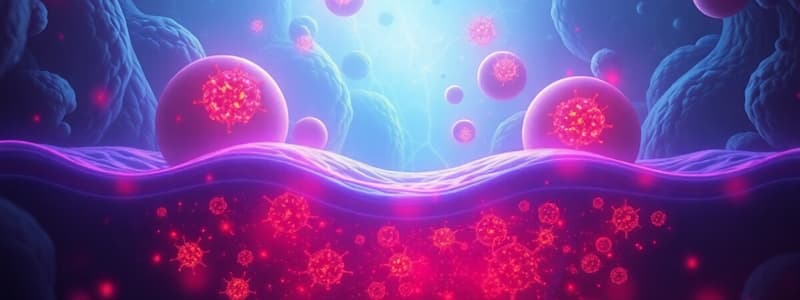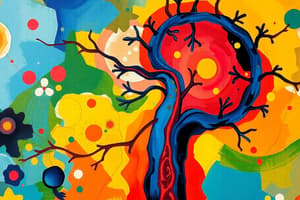Podcast
Questions and Answers
Which of the following is an example of a biochemical barrier in innate immunity?
Which of the following is an example of a biochemical barrier in innate immunity?
- The low pH of the stomach.
- Mucus secreted by epithelial surfaces. (correct)
- Membranous sheets in the genitourinary tract.
- Epithelial cells lining the respiratory tract.
What is the primary role of antimicrobial peptides in innate immunity?
What is the primary role of antimicrobial peptides in innate immunity?
- To stimulate the production of antibodies.
- To neutralize toxins produced by bacteria.
- To act as a physical barrier against pathogens.
- To exert toxic effects on bacteria, fungi, and viruses. (correct)
Which of the following characteristics is NOT typically associated with acute inflammation?
Which of the following characteristics is NOT typically associated with acute inflammation?
- Resolution within more than two weeks. (correct)
- Nonspecific response.
- Activation within seconds of damage.
- Involvement of vascularized tissues.
What is the primary function of the influx of fluid during the inflammatory response?
What is the primary function of the influx of fluid during the inflammatory response?
Which of the following describes the role of plasma protein systems in the inflammatory response?
Which of the following describes the role of plasma protein systems in the inflammatory response?
Activation of the complement system can occur via the classical pathway. What primarily activates the classical pathway?
Activation of the complement system can occur via the classical pathway. What primarily activates the classical pathway?
What is the immediate effect of histamine release from mast cells during inflammation?
What is the immediate effect of histamine release from mast cells during inflammation?
What role do chemokines play in the inflammatory response?
What role do chemokines play in the inflammatory response?
What is the function of opsonins, such as C3b molecules, in the immune response?
What is the function of opsonins, such as C3b molecules, in the immune response?
What is the role of the clotting system in inflammation?
What is the role of the clotting system in inflammation?
What is a key function of interferons?
What is a key function of interferons?
What is the primary role of neutrophils in the early stages of inflammation?
What is the primary role of neutrophils in the early stages of inflammation?
Which process describes how cells move directionally along a chemical gradient during inflammation?
Which process describes how cells move directionally along a chemical gradient during inflammation?
Which of the following is a characteristic of adaptive immunity but NOT innate immunity?
Which of the following is a characteristic of adaptive immunity but NOT innate immunity?
The generation of clonal diversity, a process critical for immune function, primarily occurs in which stage of life?
The generation of clonal diversity, a process critical for immune function, primarily occurs in which stage of life?
What is the primary function of humoral immunity?
What is the primary function of humoral immunity?
How does passive immunity differ from active immunity?
How does passive immunity differ from active immunity?
Which of the following is the MOST important factor influencing the immunogenicity of an antigen?
Which of the following is the MOST important factor influencing the immunogenicity of an antigen?
How do antibodies protect against infection?
How do antibodies protect against infection?
What does a high titer of antibody in a serum sample indicate?
What does a high titer of antibody in a serum sample indicate?
Flashcards
Innate Immunity
Innate Immunity
Natural/native immunity including epithelial barriers and inflammation, providing equal resistance and protection.
Physical Barriers
Physical Barriers
Epithelial cells and membranous sheets that cleanse surfaces to eliminate infections. Found in GI, GU, and respiratory tracts.
Biochemical Barriers
Biochemical Barriers
Epithelial surfaces that synthesize and secrete substances to trap or destroy pathogens. Includes mucus, sweat, saliva and tears.
Antimicrobial Peptides
Antimicrobial Peptides
Signup and view all the flashcards
Inflammation
Inflammation
Signup and view all the flashcards
Vascular Response
Vascular Response
Signup and view all the flashcards
Benefits of Inflammation
Benefits of Inflammation
Signup and view all the flashcards
Plasma Protein Systems
Plasma Protein Systems
Signup and view all the flashcards
Complement System Activation
Complement System Activation
Signup and view all the flashcards
Mast Cell Degranulation
Mast Cell Degranulation
Signup and view all the flashcards
Chemotactic Factor
Chemotactic Factor
Signup and view all the flashcards
Opsonins
Opsonins
Signup and view all the flashcards
Clotting System
Clotting System
Signup and view all the flashcards
Intrinsic Pathway
Intrinsic Pathway
Signup and view all the flashcards
Cytokines
Cytokines
Signup and view all the flashcards
Chemokines
Chemokines
Signup and view all the flashcards
Interleukins
Interleukins
Signup and view all the flashcards
Interferons
Interferons
Signup and view all the flashcards
Mast Cells
Mast Cells
Signup and view all the flashcards
Chemotaxis
Chemotaxis
Signup and view all the flashcards
Study Notes
Innate Immunity
- Innate immunity is a natural defense system involving epithelial barriers and inflammation for resistance and protection.
- Physical barriers include epithelial cells and membranes in the gastrointestinal (GI), genitourinary (GU), and respiratory tracts.
- Epithelial structures like goblet cells and cilia have high cell turnover to eliminate infections.
- The skin's low temperature and the stomach's low pH inhibit microbial growth.
- Biochemical barriers involve epithelial surfaces synthesizing and secreting substances to trap or destroy pathogens.
- Mucus and sebaceous glands provide antibacterial and antifungal properties.
- Sweat, saliva, and tears contain lysozyme, which attacks gram-positive bacteria.
- Antimicrobial peptides at high concentrations are toxic to bacteria, fungi, and viruses.
- Organisms in the normal biome can cause infection through skin defects or compromised immune/inflammatory responses.
Inflammation
- Inflammation is a response to cellular or tissue damage and activates rapidly in vascularized tissues.
- Inflammation relies on cellular and chemical components, including plasma proteins and is nonspecific
- Systemic inflammation can manifest as fever, leukocytosis (LEFT shift in neutrophil ratios), and changes in plasma protein synthesis (acute-phase reactants).
- Plasma protein synthesis can be pro- or anti-inflammatory and occurs primarily in the liver
- Chronic inflammation lasts over 2 weeks, potentially following an unsuccessful acute response or a distinct initial response
Exudate Accumulation
- Swelling and pain result from exudate accumulation, a watery fluid with few plasma proteins, indicative of early or mild inflammation.
- Fibrinous exudate is thick and clotted, characterizing severe or advanced inflammation.
- Purulent exudate accompanies persistent bacterial infection and contains a large number of leukocytes.
- Hemorrhagic exudate is exudate mixed with red blood cells.
Vascular Response
- Vascular responses include erythema, heat, edema, and pain.
- Arterioles constrict briefly, then vasodilate
- Microcirculation changes occur- vasodilation (decreased blood velocity, increased blood flow), increased permeability, and Diapedesis.
- Diapedesis- WBCs migrate through endothelial cell junctions into surrounding tissues
Benefits of Inflammation
- Inflammation dilutes toxins, prevents further infection and damage, and helps plasma proteins destroy bacteria.
- Neutrophils and macrophages remove cellular debris and infectious agents.
- Interaction with the adaptive immune system leads to more specific responses against pathogens.
- Inflammation helps prepare tissues for healing
Plasma Protein Systems
- Plasma protein systems are crucial for an effective inflammatory response and trigger a cascade of components which provide protection for the individual
Complement System
- Complement system activation produces an immune response, especially against bacterial infections with anaphylactic activity
- Activation can lead to anaphylactic activity in mast cell degranulation, leukocyte chemotaxis, opsonization, and cell lysis.
- The classic pathway is activated by adaptive immune system proteins like antigen-antibody complexes.
- The lectin pathway is antibody-dependent and activated by mannose-containing bacterial carbohydrates.
- The alternative pathway is activated by Gram-negative bacteria and fungal cell wall polysaccharides.
Mast Cells and Degranulation
- Mast cell degranulation releases histamine, causing vasodilation and increased capillary permeability.
Chemotaxis and Opsonins
- A chemotactic factor is a biochemical substance attracting leukocytes to inflammation sites.
- Opsonins (C3b) 'tag' microorganisms for destruction by neutrophils and macrophages.
Clotting System and Intrinsic Pathway
- The clotting system is a group of plasma proteins that form blood clots, creating a fibrin meshwork.
- Platelets trap other cells at injury sites.
- The intrinsic pathway activates when damaged vessel walls expose negatively charged subendothelial substances to Hageman Factor (XII).
Kinin System & Hageman Factor
- The Kinin System, activated by Hageman Factor, produces bradykinin, causing blood vessel dilation and smooth muscle contraction.
- Prostaglandins stimulate nerve endings, induce pain, and may increase leukocyte chemotaxis.
- Hageman Factor impacts all 3 plasma protein systems by activating clotting, controlling clotting via plasmin, activating the Kinin system, and activating the complement cascade.
- Biochemical mediators must be confined to injured tissues to prevent damage to healthy tissues.
Leukocytes
- Leukocytes include granulocytes, monocytes (precursors to macrophages), and lymphocytes (Natural Killer cells and B & T cells).
Cytokines and Chemokines
- Cytokines are intercellular-signaling molecules that bind to specific receptors and regulate innate and adaptive immunity.
- They can be pro- or anti-inflammatory, inducing synthesis of additional cellular products in target cells.
- Chemokines are chemotactic cytokines that attract leukocytes to inflammation sites and are produced by macrophages, fibroblasts, and endothelial cells.
- Cytokines and chemokines are pleiotropic, exhibiting diverse biological activities
Interleukins & Interferons
- Interleukins are biochemical messengers produced by macrophages and lymphocytes to stimulate pattern recognition receptors or other cytokines.
- Interleukin 6 is produced by macrophages & lymphocytes.
- Interferons are low molecular weight (LMW) proteins that primarily protect against viral infections and modulate inflammatory response.
- Type 1 interferons do not directly kill viruses but are secreted by virally infected cells to protect neighboring cells.
Mast Cells & Basophils
- Mast cells are important cellular activators of inflammatory responses, located close to blood vessels.
- Mast cells are activated by physical injury, chemical agents, immunologic means (IgE), bacteria, and viruses.
- They initiate other mediators like leukotrienes, prostaglandins, and platelet activating factor.
- Basophils are found in the blood and function similarly to mast cells.
Degranulation & Histamine
- Degranulation in mast cells releases histamine, chemotactic factors, and cytokines within seconds, with immediate effects.
- Histamine, a vasoactive amine, impacts many cells, particularly circulation.
- The H1 receptor is proinflammatory and present on smooth muscle cells of the bronchi.
- The H2 receptor is anti-inflammatory, suppressing leukocyte function and abundant on parietal cells of the stomach.
Chemotaxis & Leukotrienes
- Chemotaxis is the directional movement of cells along a chemical gradient formed by a chemotactic factor.
- Leukotrienes are products of arachidonic acid that affect membrane phospholipids, smooth muscle contraction, and increase vascular permeability.
Prostaglandins & Endothelial Cells
- Prostaglandins are long-chain unsaturated fatty acids made from arachidonic acid by cyclooxygenase (COX).
- Endothelial cells regulate normal blood flow by preventing clotting.
Nitric Oxide, Prostacyclin, & Platelets
- Nitric Oxide (NO) is produced from arginine, while prostacyclin (PGI2) is derived from arachidonic acid.
- Both relax vascular smooth muscle, suppress cytokine effects, and maintain vascular tone.
- Platelets circulate until vascular injury occurs, leading to activation.
- Activation causes a coagulation cascade to stop bleeding, releases serotonin, and synthesizes TXA2.
TXA2 & Phagocytosis
- TXA2 is a potent vasoconstrictor and inducer of platelet aggregation, suppressible by low-dose aspirin.
- Phagocytosis involves a cell ingesting and disposing of damaged cells, foreign material, and microorganisms.
- Opsonization prepares the target
- Engulfment forms a phagosome
- The phagosome fuses with lysosomal granules to form a phagolysosome
- Destruction of the target occurs
Neutrophils, Eosinophils, & Basophils
- Neutrophils are the predominant phagocytes in early inflammation, arriving within 6-12 hours, activated by mediators.
- Eosinophils are mildly phagocytic defense against parasites and regulate vascular mediators released from mast cells.
- Basophils are similar to mast cells.
Dendritic Cells, Monocytes, & Granuloma
- Dendritic cells link the innate and adaptive immune responses, located in peripheral organs/skin, migrating to lymphoid tissue to interact with T lymphocytes.
- Monocytes are the largest normal blood cells that are produced in the bone marrow,migrate to the site of inflammation and develop into macrophages
- Monocyte-derived macrophages appear at the site in circulation within 24 hours but typically 3 to 7 days later.
- Granuloma is a walled-off area of infection that macrophages cannot limit.
Wound Healing
- Wound healing involves filling in, sealing, and shrinking.
- The inflammatory phase includes fibrin mesh and scaffolding with platelets, neutrophils, and macrophages.
- The proliferative phase begins 3-4 days post-injury, lasting up to 2 weeks, involving macrophage invasion, fibroblast recruitment/proliferation, collagen synthesis, epithelialization, contraction, and cellular differentiation.
- Wound Contraction is the final process, necessary for all wounds but especially those undergoing secondary intention.
- Tissue remodeling and maturation begins weeks after injury, completing normally within 2 years.
- The reconstructive phase involves assembly and remodeling of the collagen matrix, epithelialization, and contraction.
Collagen Synthesis
- Dysfunctional collagen synthesis leads to hypertrophic scars or keloids.
Adaptive Immunity
- Adaptive immunity is the third line of defense which augments defenses, provides security against reinfection, is slower than inflammation, is inducible and specific, and has memory.
- Central Lymphoid Organs include the Thymus and bone marrow
- Peripheral Organs include Peyer's patches in the Ilieum, Adenoids, Tonsils, lymph nodes and Spleen
Clonal Diversity
- Clonal Diversity occurs in fetus, which involves recognizing almost any foreign antigen.
- Lymphoid stem cells migrate to lymphoid organs from the bone marrow.
- Differentiation results in immunocompetent cells that migrate to secondary organs and take up residence
Clonal Selection
- Clonal Selection begins at birth, and continues as new antigens are encountered, memory B cells produce more antibodies upon second challenge with the antigen.
- Begins in lymphoid organs and the appendix.
Humoral Immunity
- Humoral Immunity protects against viruses and bacteria and defends against extracellular microbes and microbial toxins.
Types of Immunity
- Active Immunity is acquired and produced after natural exposure to an antigen or after immunization
- Passive Immunity occurs through the passage of maternal antibodies across the placenta or artificially through immunotherapy (temporary).
Antigens
- Antigens can react with binding sites on antibodies or receptors on B & T cells.
- The most important feature is to be foreign to the host
- Has to be an appropriate size, chemical complexity, and present in sufficient quantity
Antibodies
- Antibodies: serum proteins produced by plasma cells in response to an immunogen.
- Its chief function is to protect against infection via neutralization, agglutination and precipitation.
- IgG: most abundant, proactive against infection.
- IgA1 is found in blood, IgA2 is found in body secretions.
- IgM is the largest, is produced during the first initial response.
- IgE is normally low, is a mediator in allergic response.
B & T Cell Maturation
- B Cells reside in bone marrow where they are exposed to hormones and cytokines that influence proliferation and differentiation.
- T Cell maturation is similar to B cells but found in the Thymus
- B cell Clonal Selection- Immunocompetent cells encounter antigens for the first time, memory cells become factories for anitbodies.
Titer & Immunity
- Titer is a measure of the amount of antibodies
- Secondary Immune response: a faster production, due to memory cells.
- Vaccines may produce long-lived protection but most require boosters at specific intervals
Studying That Suits You
Use AI to generate personalized quizzes and flashcards to suit your learning preferences.



